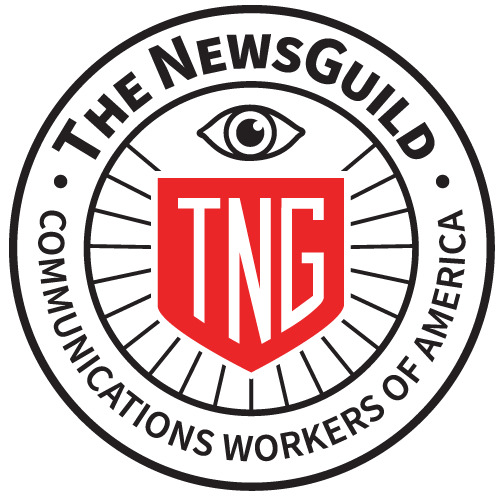About The NewsGuild-CWA (TNG-CWA)
The NewsGuild-CWA fights for justice on the job for journalists and other workers.
In today’s tough media environment, journalists and other communications professionals are expected to do it all – create content for multiple platforms, build a following on social media, and meet high journalistic standards – and to do it practically 24/7.
But turmoil in the industry has left many of us with stagnant wages, an overwhelming workload and little or no input on the job. And the upheaval – which has been exacerbated by the COVID-19 pandemic – has undermined our ability to hold the powerful accountable and to tell the stories of our communities.
Journalists have responded with a surge in organizing with The NewsGuild, the largest union of communications employees in North America. Approximately 7,300 of the Guild’s 27,000 members have joined since 2018 at more than 120 newly unionized publications.
Who we are
The NewsGuild’s members include journalists at print-and-digital news organizations and digital-only publications – reporters, columnists, copy editors, photojournalists, videographers, graphic designers, editorial cartoonists and others. Members work at newspapers, online publications, magazines, news services and in broadcast in the U.S., Canada and Puerto Rico.
In addition to journalists, the NewsGuild represents workers in advertising, circulation, business offices and other departments essential to the operations of media enterprises.
The Guild also represents other communications employees – publishing house employees, spoken-language and sign-language interpreters and translators, social justice workers, and the staff of nonprofit organizations.
As a sector of the Communications Workers of America and the AFL-CIO, The NewsGuild is part of a revitalized labor movement.
What we do
The NewsGuild has the resources, experience and commitment to advance the fight for dignity and respect on the job along with good pay and benefits. Guild members have extensive experience negotiating contracts that guarantee professional pay, health insurance, retirement benefits, vacation time, sick leave, parental leave, due process, “just cause” and much more. At any given time, NewsGuild members are enforcing more than 200 agreements that our members negotiated with employers.
But The NewsGuild does much more than that. We keep abreast of trends in the industry – from the consolidation of ownership to emerging business models – and we advocate for journalists and high-quality journalism.
We organize new members to expand our community and build workers’ power on the job.
We fight to end disparities in pay, and we demand to know why so many of the nation’s most prestigious news organizations still pay women and people of color less than their counterparts.
We work with press freedom organizations to defend our right to report – free from assault, arrest and intimidation – and we defend the people’s right to know.
Our history
The American Newspaper Guild was formed in 1933 during the wave of unionization that arose during the Great Depression. It was led by Heywood Broun, a well-known and highly respected columnist who championed the underdog.
The union affiliated with the American Federation of Labor in 1936 and with the Congress of Industrial Organizations in 1937 after expanding to include non-editorial employees. (The two organizations merged in 1955 to form the AFL-CIO.)
In the 1970s, the Guild dropped “American” from its name to reflect the fact that it had expanded to Canada in the 1950s.
In 1995, the Guild became a sector of the Communications Workers of America, a progressive union that includes employees in the telecommunications industry, information technology, airline industry, public service and other fields.
The Newspaper Guild renamed itself The NewsGuild in 2015 to reflect changes in the industry: News is no longer the province of print publications alone. The Guild had begun representing digital employees, who worked in separate departments from print employees, in the 1990s and organized its first digital-only newsroom, Truthout, in 2009.
